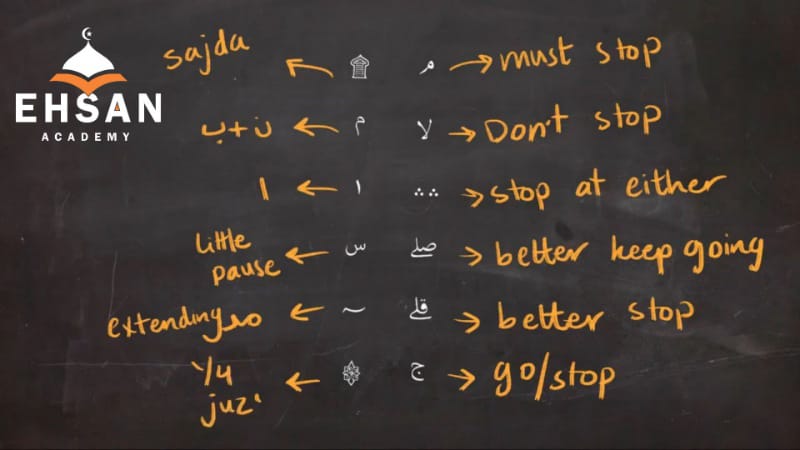Symbols in the Quran
Table of Contents
Quran stop signs
The rules of stopping in Quran are very important to anyone who wants to recite The glorious book of almighty Allah, the holy Quran, contains within it the ultimate guidance, and secrets of leading a peaceful life. It is a powerful book that can help us get close to Allah and achieve a beautiful place in Jannah.
Allah and His prophet Muhammad (peace be upon him) have guided us to recite the Holy Quran beautifully and act upon its laws and guidance. To get a clear understanding of the meanings of the Holy Quran and recite the verses of the Holy Quran, it is essential for every Muslim to learn the rules and tajweed of reading the Holy Quran.
Quranic Arabic is a versatile language. A slight mistake in recitation of the Holy Quran can completely change the meaning of the entire verse. One of the essential aspects of the Quranic symbols is the rules and signs of stopping, also known as Waqf.
You may have noticed various Quran stop signs and symbols in the Quran middle portion or after the end of the verse. These symbols represent places to pause, stop, and continue the reading. This article will discuss the importance, rules, and signs of stopping in the Holy Quran with examples of Quranic texts.
What are the rules of Waqf in Quran?
Before moving toward the rules and importance of stopping signs of the holy Quran, let’s first understand the definition of the waqf.
The word “Waqf” originated from the Arabic language, which means “stop.” it indicates that the reciter should cut off the sound at the end of a word for a brief period while intending to continue the recitation after the pause.
The various symbols of waqf signal the readers to stop reading during the recitation. Waqf signs are represented in the middle or end of the verse but never come in the middle of the word. These stopping signs help us understand the meaning of the particular verse.
Importance of stopping signs in the Quran when reading the Quran
The stopping signs in the Holy Quran have great significance, and their proper use ensures the correct pronunciation, intonation, and meaning of the text. The signs of stopping in the Holy Quran play a crucial role in distinguishing the verses that require compulsory stops and optional pauses.
It is highly important to follow these stopping signs in Quran, particularly with the verses that provide guidance, commandments, prohibitions, or descriptions, as it can entirely change the meaning of the verse.
When reading the Quran, the stopping rules in the Quran aid in comprehending the context of the verses and their relationship with the preceding and succeeding verses. They make the reciter pause, reflect and ponder over the diving message and absorb the guidance deeply. Consequently, for a thorough understanding and better recitation of the holy Quran with tajweed, the proper use of stopping signs is essential.
The Effect of Quran stopping rules on Understanding the Quranic Text
“Eat not drink”
“Eat not, drink”
From the first sentence, we can drive the meaning that we are asked to eat and forbidden to drink, while the second sentence gives the completely opposite meaning as it asks to drink and forbids eating.
The little change of stopping when reading the Quran can alter the meaning and message given in the particular verse. Therefore, it is crucial for every Muslim to learn the rules and tajweed of reciting the Quran.
Example of Quranic verse
For example, if we consider the following verse from Surah Al-Kafirun:
“لَكُمْ دِينُكُمْ وَلِيَ دِينِ“
Translation: “To you, your religion, and to me, my religion.”
However, if we stop at the wrong place after “to me,” the entire meaning of the verse changes to “To you, your religion, and to me, the consequences of my actions.” This example highlights the importance of stopping signs and pausing signs in the right areas during recitation.
Where to stop in Quran & Quran symbols meaning in English
- – The Conclusion of Verse:
This circular symbol in Quran represents the endpoint of a specific verse in the Holy Quran. It is also known as “waqf e taam” in Arabic. The symbol is the perfect stopping sign, indicating the conclusion of the Quranic verse.
The reciter must pause here, take a breath, and then continue with the next verse. This pause allows the reciter to reflect on the message conveyed in the verse. This symbol emphasizes the completion and significance of the message delivered in the particular verse.
Example:
ٱلْحَمْدُ لِلَّهِ رَبِّ ٱلْعَـٰلَمِينَ
- مـ – The Compulsory Stop:
The symbol مـ, also known as “waqf e laazim” in Arabic, is a compulsory stop sign. It indicates the point where the reciter must stop reading and take a brief pause before continuing. Failing to stop at the “waqf e laazim” can significantly alter the meaning of the verse. The symbol emphasizes the importance of pausing to understand the verse’s meaning, providing an opportunity to reflect on the message being conveyed.
۞ إِنَّمَا يَسْتَجِيبُ ٱلَّذِينَ يَسْمَعُونَ ۘ وَٱلْمَوْتَىٰ يَبْعَثُهُمُ ٱللَّهُ ثُمَّ إِلَيْهِ يُرْجَعُونَ ٣٦
- ج – The Permissible Stop:
The symbol ج represents “waqf e jaiz,” a permissible stop sign in the Holy Quran. It indicates the place where stopping or pausing before continuing to the next verse is allowed. This symbol points toward the completion of a particular topic mentioned in the part of the verse. Although it is not obligatory to stop at this sign, taking a pause before reading the other part of the verse can help the reciter absorb the meaning.
فَسَبِّحْ بِحَمْدِ رَبِّكَ وَٱسْتَغْفِرْهُ ۚ إِنَّهُۥ كَانَ تَوَّابًۢا
- لا – No Need of Stopping
The symbol “لا” or “laa” indicates that the reciter should continue with the recitation without taking a break. Pausing here may alter the meaning of the verse. However, pausing becomes permissible when this symbol appears with a circular mark of conclusion at the end of the verse.
وَمَا جَعَلْنَآ أَصْحَـٰبَ ٱلنَّارِ إِلَّا مَلَـٰٓئِكَةًۭ ۙ وَمَا جَعَلْنَا عِدَّتَهُمْ إِلَّا فِتْنَةًۭ لِّلَّذِينَ كَفَرُوا۟ لِيَسْتَيْقِنَ ٱلَّذِينَ أُوتُوا۟ ٱلْكِتَـٰبَ وَيَزْدَادَ ٱلَّذِينَ ءَامَنُوٓا۟ إِيمَـٰنًۭا ۙ وَلَا يَرْتَابَ ٱلَّذِينَ أُوتُوا۟ ٱلْكِتَـٰبَ وَٱلْمُؤْمِنُونَ ۙ وَلِيَقُولَ ٱلَّذِينَ فِى قُلُوبِهِم مَّرَضٌۭ وَٱلْكَـٰفِرُونَ مَاذَآ أَرَادَ ٱللَّهُ بِهَـٰذَا مَثَلًۭا ۚ
- ∴–The Embracing Stop
Mu’aanaqah” is a symbol that indicates stopping at one of the triplets included in it, with no discontinuance at the same time. In the holy Quran, two muaanaqah symbols appear together which highlights that a reciter should pause at one sign and continue reading at the second one.
ذَٰلِكَ ٱلْكِتَـٰبُ ۛ لَا رَيْبَ ۛ فِيهِ ۛ هُدًۭى لِّلْمُتَّقِينَ
- صلي– Preference for Continuation
The sign صلي is called Al-wasl Awlaa. This is an indication that there is no need to take a break and a reciter should continue recitation.
Example : كَلَّا ۖ لَيُنۢبَذَنَّ فِى ٱلْحُطَمَةِ
- قلي – Better not to Stop
“Qeeli” is a sign that shows that it is better to stop recitation
example: بَعْدِ نُوحٍۢ ۗ
- س – The Silence Symbol
“Saktah” is a sign at which the reciter should take a little pause without breaking its breath before keeping on reciting further. besides if we see the letter seen (س) on top of letter sad (ص) we will make (ص) silent and pronounce seen (س) and if seen (س) below sad (ص), we will pronounce sad and skip seen
example: وَقِيلَ مَنْ ۜ رَاقٍ

Benefits of stop signs in Quran
In Quranic recitation, there are certain rules of stopping (وَقْف) that dictate where to pause and where to continue reciting. These rules are important for proper pronunciation and understanding of the Quran. Here are some benefits of learning and applying the Quran stop signs:
- Enhancing understanding: The Quran stopping rules in Quranic recitation help to clarify the meaning and context of the verses being recited. Pausing at the right places can help the listener to better understand the intended message of the Quran.
- Improving pronunciation: Proper application of the rules of stopping can improve one’s pronunciation of the Quran. Pausing at the right places can help to emphasize certain letters and sounds, which can enhance one’s overall recitation.
- Honoring the word of God: The Quran is considered the word of God, and proper recitation with correct pauses and intonation is a way of showing respect and reverence for the holy book.
- Strengthening of faith: Learning and applying the rules of stopping in Quranic recitation can help to deepen one’s connection with Allah and strengthen one’s faith.
- Increased reward: Muslims believe that reciting the Quran with proper Tajweed (rules of Quranic recitation) and applying the rules of stopping will earn them great rewards and blessings from Allah.
In summary, learning and applying the rules of stopping in Quranic recitation can enhance understanding, improve pronunciation, show respect for the holy book, strengthen faith, and bring great rewards and blessings from Allah.
Conclusion:
The rules of stopping signs in the Quran, known as Waqf, are a critical aspect of the Arabic language and Quran recitation. It is essential to practice these rules accurately, along with perfecting the Tajweed rules, to ensure correct recitation and understanding of the Holy Quran.
As Muslims, it is our duty to learn and practice the rules of the Quran, including the Rules of Stopping in Quran, as even a slight mistake in understanding the signs or rules of stopping can completely change the meaning of the verse, making us sinful.
Therefore, we must strive to learn the correct way of recitation to attain the pleasure of Allah, who is forgiving but also wants us to strive for excellence.
Final words:
Are you determined to learn the Holy Quran and perfect your recitation? It is your duty to learn, and it is our duty to provide you with the best tutors who will help you achieve excellence in Quran recitation. At Ehsan Academy, our teachers use modern methodology and updated techniques to help you master the Holy Quran from the comfort of your own home at a flexible schedule.
What’s more?
We also offer free trial classes! Enroll now and start your journey towards Allah and His Book with us!
FAQs
What are stop signs in Quran?
Stop signs in Quran are known as Waqf or pause signs. They indicate the areas that require mandatory stops, negative stops, and optional stops to ensure accurate reading of the Quranic text.
What is the Tajweed rule of stopping?
The tajweed rule of stopping is called “Waqf.” it is crucial for the correct recitation of the holy Quran. The waqf signs also ensure the accurate meaning of the verse is conveyed.
Should we stop at Jeem in the Quran?
The symbol jeem in the holy points toward the completion of a particular topic mentioned in the part of the verse. It is not obligatory to stop at this sign, but taking a pause before reading the other part of the verse can help the reciter absorb the meaning.
Quran stop pause marks/ Quran stops and pauses
In the Holy Quran, stopping symbols or pause signs indicates where to stop and where to continue the reading. The most common Waqf signs include the letter “Sad,” “Lam,” “Mim,” and “Ba.”
How can one learn and apply the rules of stopping in Quran?
Learning and applying the rules of stopping in Quran requires some effort and practice. Here are some steps to help you learn and apply these rules:
Learn the rules: The first step is to learn the Rules of Stopping in Quran. There are several books and resources available that explain these rules in detail. Some popular resources include “Tajweed Rules of the Quran” by Kareema Carol Czerepinski and “The Rules of Tajweed” by Sheikh Abu Bakr Shatri.
Practice with a teacher: It is recommended to practice Quranic recitation with a qualified teacher who can guide you and provide feedback on your pronunciation and application of the rules of stopping. Many Islamic centers and mosques offer Quranic recitation classes with qualified teachers.
Listen to reciters: Listening to reciters who have mastered the rules of stopping in Quranic recitation can help you to better understand how to apply these rules in your own recitation. Some popular reciters include Sheikh Abdullah Basfar, Sheikh Sudais, and Sheikh Mishary Al-Afasy.
Memorize and recite: Memorizing portions of the Quran and reciting them with proper Tajweed and application of the rules of stopping can help you to internalize these rules and improve your recitation.
Seek feedback: It is important to seek feedback from your teacher or other qualified individuals to ensure that you are applying the rules of stopping correctly. This can help you to identify areas that need improvement and to make necessary adjustments.







